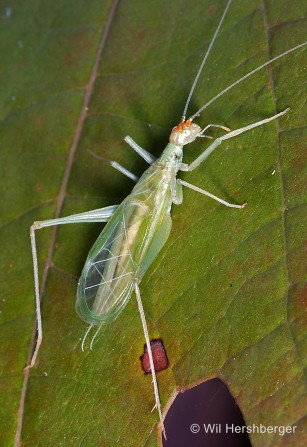Snowy Tree Cricket – Nature’s Thermometer
A Nature Video Vignette by Lang Elliott
Perhaps the most familiar of our tree crickets, the Snowy Tree Cricket (Oecanthus fultoni) is a species whose chirp rate can be used to estimate the temperature. One popular formula is to count the number of songs given in thirteen seconds and then add that number to 40 to yield the temperature in Fahrenheit. That’s seems easy enough, so why not determine for yourself the approximate temperatures of the two singing males featured in the above video … then share your results in the comment section below.
This wide-ranging tree cricket, found across much of the United States, is referred to as “Snowy” because individuals are sometimes so pale that they appear white (although a number of other tree cricket species are similarly attired). It frequents brushy understory plants at the margin of woods or within open woods. During cold spells, Snowys can also be found close to the ground on the trunks of small trees – here they probably find a warmer microenvironment.
The male’s song is a pleasant series of evenly-spaced chirps, each chirp actually consisting of 8 (occasionally 5) pulses, given too fast to differentiate. Males prefer to sing from the underside of branches or dead leaves, but sometimes position themselves in a hole in a leaf or else in the “V” created when two leaves overlap (as demonstrated in the video). Furthermore, as you can see for yourself in the video, they have no problem singing upside down!
Stereo Soundscape Featuring Snowy Tree Crickets:
Two neighboring males (one to the right and the other to the left) begin singing in unison but occasionally drift apart and then return to unison. It is common for neighbors to synch their songs in this manner. From a distance, one might actually think it’s just one cricket singing. Note the Barred Owl hooting in the background.
Recorded 11 August 2010 around 11pm near Ithaca, New York. © Lang Elliott.
Snowy Tree Crickets can be very difficult to locate because of the ventriloquial quality of their song. Finding them is further confused by sound reflecting off of, and being absorbed by, surrounding leaves. Sometimes, a male’s call actually gets softer as you approach him, because nearby leaves block the sound. In addition, if you shine a flashlight in the direction of the singing male, he’ll usually collapse his wings and then hide behind a leaf, at times giving his position away unknowingly as he waves his antennae beyond the leaf’s edge.
Notes from the Author (Lang Elliott):
 Of all our native tree crickets, this one is my favorite, due to its pleasant demeanor and its sweet, rather low-pitched song. But one thing is for certain: these buggers are difficult to videotape while singing! Not only are they hard to find, but they are easily disturbed, and they don’t like to be in the light.
Of all our native tree crickets, this one is my favorite, due to its pleasant demeanor and its sweet, rather low-pitched song. But one thing is for certain: these buggers are difficult to videotape while singing! Not only are they hard to find, but they are easily disturbed, and they don’t like to be in the light.
I worked very hard to get the two singing sequences in the video, enticing the two males to sound off by turning my light off, and then back on when they finally started performing. After a few tries, they seemed to get used to my antics. I can’t wait to capture more footage of this fantastic insect songster!



